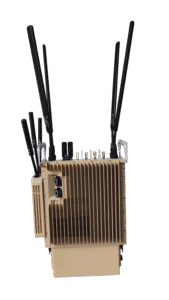 Nokia has launched a military-grade smartphone built “almost entirely” from non-Chinese components as it increases its focus on NATO-aligned military markets.
Nokia has launched a military-grade smartphone built “almost entirely” from non-Chinese components as it increases its focus on NATO-aligned military markets.
It has also launched an upgraded tactical radio – the Banshee 5G Tactical Radio – which adds 5G capabilities to the tactical radio it acquired when it bought Fenix in 2024.
Giuseppe Targia, Senior Vice President, Space & Defense, Mobile Networks, Nokia, said that the new Mission-Safe phone has no “active components” of Chinese origin, and that 90% of the total component used in the device are non-Chinese. The core of the phone is the Qualcomm Snapdragon chip, and the device is also manufactured in Europe. “So we can guarantee safety from the supply chain and component point of view,” Targia said. The device can support the Google device OS with customisable services, but it can also be offered as a version with direct access to the lower level so that partners can install their own operating system. “That’s something unique in the market,” he added.
The Banshee is a rugged, portable mobile ‘network in a backpack’ that weighs less than 10kg including the battery and can create a tactical network anywhere it is needed. Nokia said that it could be used in mobile command posts and in dispersed units supporting secure communications even under electromagnetically contested conditions.
Targia said that Nokia initially bought Fenix because although Fenix used Nokia products to build its solutions, it actually had a better idea of what customers in the defence sector wanted than Nokia itself, and brought with it access to classified and top secret level work in the USA.
3GPP as a NATO standard
Modern warfare has changed the communications requirement, with the need for control of devices and objects such as drones, as well as visibility and the ability to access data to support analytics for automated decision making.
To that end, commercial 5G technology can provide faster, more secure, and more cost-effective communications than legacy or proprietary systems, “making it a transformative enabler for defence,” in Targia’s words.
Nokia told TMN: “NATO recognises 5G as a strategic enabler for multi-domain operations, highlighted in STANAG 5665. This standard makes 5G a secure, interoperable, and high-capacity platform built for multinational defense use. With 5G, military forces can connect mission-critical applications and integrate advanced technologies such as IoT devices, sensors, drones, autonomous platforms, and AR/VR tools, delivering high-bandwidth, low-latency communications even in contested environments.
“The information gathered by 5G systems such as our Nokia Banshee 5G Tactical Radio, can then be analysed and used locally and sent, through different backhaul options (MANET, Microwave, Satellite), to remote mobile command and control centres, where a cloud system can process and analyse information using AI based systems.”
Nokia’s defence opportunity
 As defence budgets increase, so does the opportunity for a company like Nokia to sell advanced military communications systems that can support new warfare methods.
As defence budgets increase, so does the opportunity for a company like Nokia to sell advanced military communications systems that can support new warfare methods.
Nokia’s Targia said, “We see defense as a good mid-to long-term growth area. It also helps drive innovation in our industry, strengthening our overall technology along with the direct sales opportunity.”
He added that although non-3GPP aligned companies play down the tactical importance of 3GPP solutions, at the same time they want to work with Nokia on combined solutions. And he adds that other 3GPP players – including Ericsson – are not really focussed on defence in the way Nokia is.
“We don’t see Ericsson. I don’t think in this moment they are really focussed on this market,” he said.
For Nokia, NATO countries provide a strong opportunity for sales, as those markets are unlikely to buy outside of the Western manufacturers. Targia said that almost all NATO countries have expressed an interest in proofs of concept and discussing 5G with Nokia, and that the company is working with over 50% of those. It also has concrete deals in Asia with non-NATO countries, so it’s not just a NATO market For Nokia.
“It sounds not nice but the current situation has resulted in a significant increase in investment, up to 5% of GDP in Europe, but not only in Europe. The rest of the world is also going to re-arm. But even more important is that the Ukraine war, and technology development in general, has changed the way war is conducted.
“Situational awareness is becoming extremely important – to understand what the enemy has. Electronic warfare is becoming fundamentally important – so awareness and control of telecommunications and Internet of Things on the battlefield is becoming extremely important.
“On the one side we have more sophisticated end devices – drones or robots – and on the other we have the need for more advanced ways to analyse data. AI will also play a very significant role in the way decisions are taken, but what is missing is the link between these sensors, robots and drones and the AI capability. The tactical radios of today have been created mainly to transport voice and little bits of data. This is not adequate to this new scenario, which we believe will require a much more efficient communication system.”